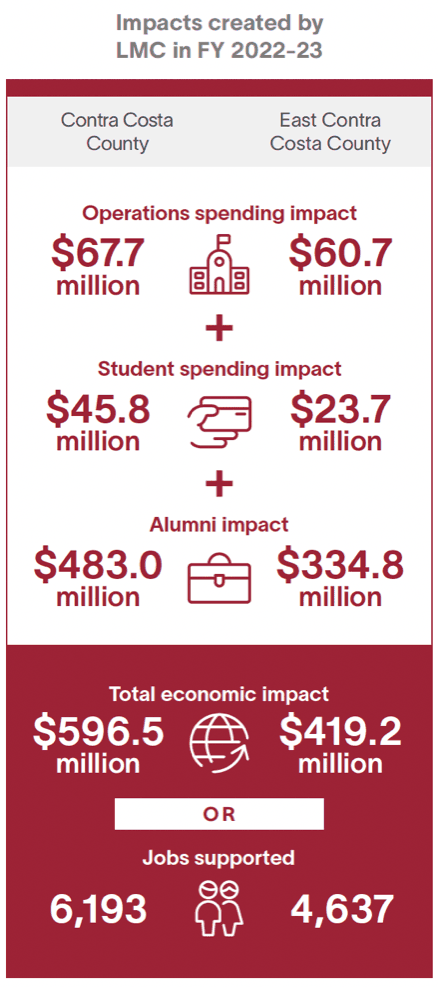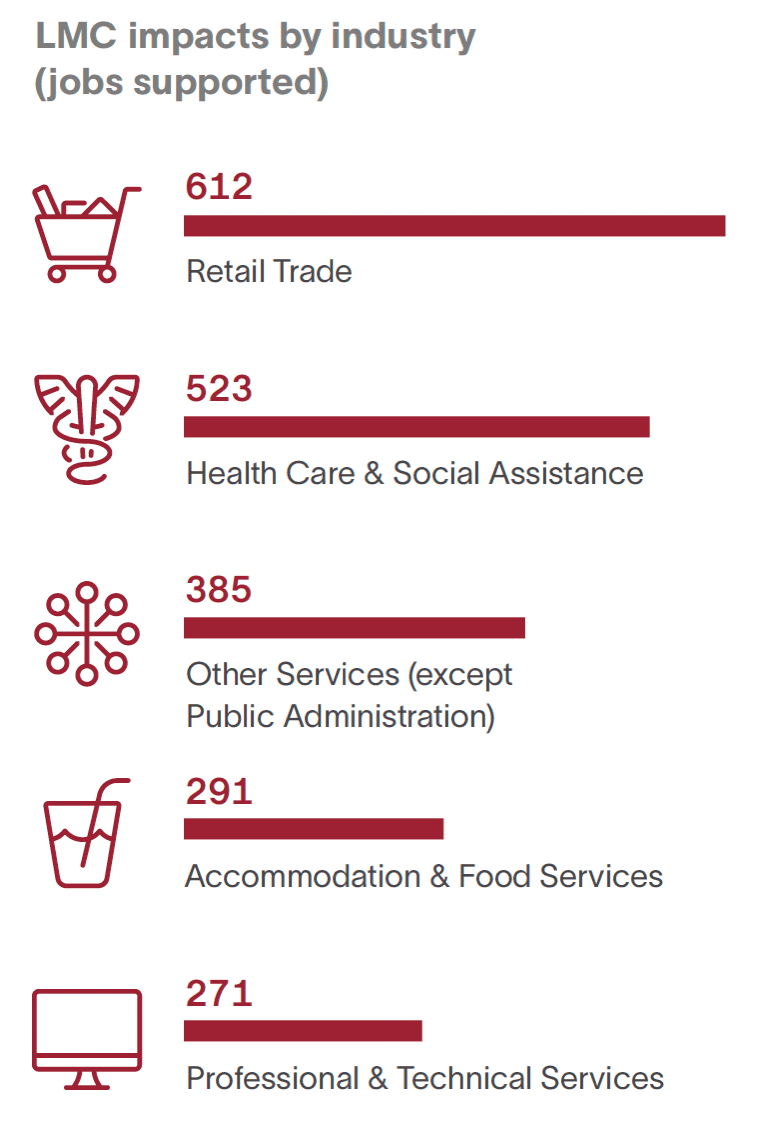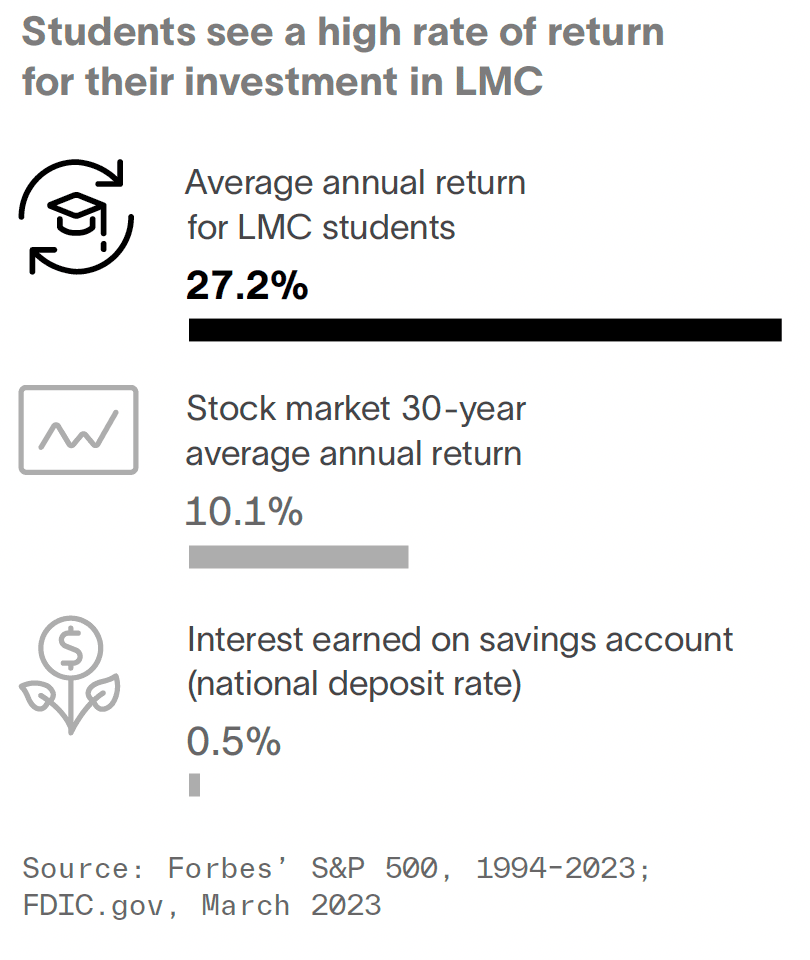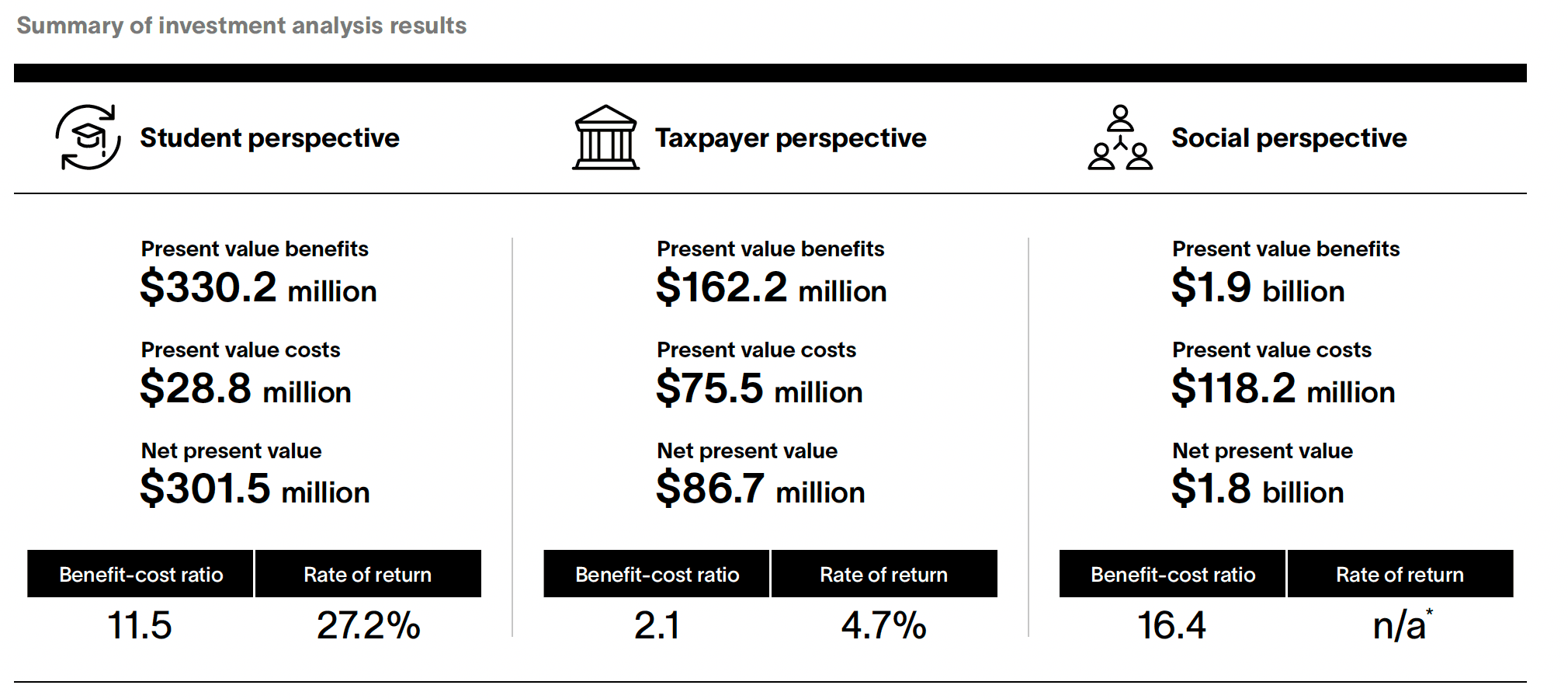The Economic Value of Los Medanos College


LMC influences both the lives of its students and the regional economy.
LOS MEDANOS COLLEGE (LMC) creates value in many ways. The college plays a key role in helping students increase their employability and achieve their individual potential. The college draws students to the region, generating new dollars and opportunities for East Contra Costa County.* LMC provides students with the education, training, and skills they need to have fulfilling and prosperous careers. Furthermore, LMC is a place for students to meet new people, increase their self-confidence, and promote their overall health and well-being.
LMC influences both the lives of its students and the regional economy. The college supports a variety of industries in East Contra Costa County, serves regional businesses, and benefits society as a whole in California from an expanded economy and improved quality of life. Additionally, the benefits created by LMC extend to the state and local government through increased tax revenues and public sector savings.
This study measures the economic impacts created by LMC on the business community and the benefits the college generates in return for the investments made by its key stakeholder groups—students, taxpayers, and society. The following two analyses are presented:
Investment analysis
All results reflect employee, student, and financial data, provided by the college, for fiscal year (FY) 2022-23. Impacts on the East Contra Costa County economy are reported under the economic impact analysis and are measured in terms of added income. The returns on investment to students, taxpayers, and society in California are reported under the investment analysis.
For the purposes of this analysis, East Contra Costa County is comprised of the following zip codes: 94505, 94509, 94511, 94513, 94514, 94531, 94548, 94561, and 94565.
Economic impact analysis
LMC promotes economic growth in East Contra Costa County through its direct expenditures and the resulting expenditures of students and regional businesses. The college serves as an employer and buyer of goods and services for its day-to-day and construction operations. The college’s activities attract students from outside East Contra Costa County, whose expenditures benefit regional vendors. In addition, LMC is one of the primary sources of higher education to East Contra Costa County residents and a supplier of trained workers to regional industries, enhancing overall productivity in the regional workforce.
Operations spending impact
LMC adds economic value to East Contra Costa County as an employer of regional residents and a large-scale buyer of goods and services. In FY 2022-23, the college employed 947 full-time and part-time faculty and staff, 48% of whom lived in East Contra Costa County. Total payroll at LMC was $56.4 million, much of which was spent in the region for groceries, mortgage and rent payments, dining out, and other household expenses. In addition, the college spent $36.9 million on expenses related to facilities, supplies, and professional services (excluding construction).
LMC’s operations spending added $60.7 million in income to the region during the analysis year. This figure represents the college’s payroll, the multiplier effects generated by the in-region spending of the college and its employees, and a downward adjustment to account for funding that the college received from regional sources. The $60.7 million in added income is equivalent to supporting 971 jobs in the region.
 Student spending impact
Student spending impact
Around 22% of students attending LMC originated from outside the region in FY 2022-23, and some of these students relocated to East Contra Costa County to attend LMC. These students may not have come to the region if the college did not exist. In addition, some in-region students, referred to as retained students, would have left East Contra Costa County if not for the existence of LMC. While attending the college, these relocated and retained students spent money on groceries, accommodation, transportation, and other household expenses. This spending generated $23.7 million in added income for the regional economy in FY 2022-23, which supported 329 jobs in East Contra Costa County.
Alumni impact
The education and training LMC provides for regional residents has the greatest impact. Since the establishment of the college, students have studied at LMC and entered the regional workforce with greater knowledge and new skills. Today, thousands of former LMC students are employed in East Contra Costa County. As a result of their education from LMC, the students receive higher earnings and increase the productivity of the businesses that employ them. In FY 2022-23, LMC alumni generated $334.8 million in added income for the regional economy, which is equivalent to supporting 3,336 jobs.

One out of every 23 jobs in East Contra Costa County is supported by the activities of LMC and its students.
Total impact
LMC added $419.2 million in income to the East Contra Costa County economy during the analysis year, equal to the sum of the operations spending impacts; the student spending impact; and the alumni impact. For context, the $419.2 million impact was equal to approximately 3.2% of the total gross regional product (GRP) of East Contra Costa County. This contribution that the college provided on its own is nearly twice the size of the entire Transportation & Warehousing industry in the region.
LMC’s total impact can also be expressed in terms of jobs supported. The $419.2 million impact supported 4,637 county jobs, using the jobs-to-sales ratios specific to each industry in the region. This means that one out of every 23 jobs in East Contra Costa County is supported by the activities of LMC and its students. In addition, the $419.2 million, or 4,637 supported jobs, stemmed from different industry sectors. For instance, among non-education industry sectors, the spending of LMC and its students and the activities of its alumni in the Health Care & Social Assistance industry sector supported 523 jobs in FY 2022-23. If the college did not exist, these impacts would not have been generated in East Contra Costa County.
 Investment analysis
Investment analysis
An investment analysis evaluates the costs associated with a proposed venture against its expected benefits. The analysis presented here evaluates LMC as an investment from the perspectives of students, taxpayers, and society in California. As with the economic impact analysis, this analysis considers only FY 2022-23 activities.
Student perspective
In FY 2022-23, LMC served 11,727 credit and 263 non-credit students. To attend the college, the students paid for tuition, fees, books, and supplies. They also took out loans and will incur interest on those loans. Additionally, students gave up money they would have otherwise earned had they been working instead of attending college. The total investment made by LMC’s students in FY 2022-23 amounted to a present value of $28.8 million, equal to $10.2 million in out-of-pocket expenses (including future principal and interest on student loans) and $18.6 million in forgone time and money.
In return for their investment, LMC’s students will receive a stream of higher future earnings that will continue to grow throughout their working lives. For example, the average LMC associate degree graduate from FY 2022-23 will see annual earnings that are $10,500 higher than a person with a high school diploma or equivalent working in California. Over a working lifetime, the benefits of the associate degree over a high school diploma will amount to an undiscounted value of $451.5 thousand in higher earnings per graduate. The present value of the cumulative higher future earnings that LMC’s FY 2022-23 students will receive over their working careers is $330.2 million.
The students’ benefit-cost ratio is 11.5. In other words, for every dollar students invest in LMC in the form of out-of-pocket expenses and forgone time and money, they will receive a cumulative value of $11.50 in higher future earnings. Annually, the students’ investment in LMC has an average annual internal rate of return of 27.2%, which is impressive compared to the U.S. stock market’s 30-year average rate of return of 10.1%.

Average earnings by education level at career midpoint
The average associate degree graduate from LMC will see an increase in earnings of
$10,500 each year compared to a person with a high school diploma or equivalent working in
California.
Taxpayer perspective
For every dollar of public money invested in LMC, taxpayers will receive a cumulative value of $2.10 over the course of the students’ working lives
LMC generates more in tax revenue than it receives. These benefits to taxpayers consist primarily of taxes that the state and local government will collect from the added revenue created in the state. As LMC students will earn more, they will make higher tax payments throughout their working lives. Students’ employers will also make higher tax payments as they increase their output and purchases of goods and services. By the end of the FY 2022-23 students’ working lives, the state and local government will have collected a present value of $144.2 million in added taxes.
Benefits to taxpayers will also consist of savings generated by the improved lifestyles of LMC students and the corresponding reduced government services. Education is statistically correlated with a variety of lifestyle changes. The education that LMC students receive will generate savings in three main categories: 1 )health care, 2) justice system and 3) income assistance. Improved health will lower students’ demand for national health care services. In addition, costs related to the justice system will decrease. LMC students will be more employable, so their reduced demand for income assistance such as welfare and unemployment benefits will benefit taxpayers. For a list of study references, contact the college for a copy of the main report. Altogether, the present value of the benefits associated with an education from LMC will generate $18 million in savings to state and local taxpayers.
Total taxpayer benefits amount to $162.2 million, the present value sum of the added tax revenue and public sector savings. Taxpayer costs are $75.5 million, equal to the amount of state and local government funding LMC received in FY 2022-23. These benefits and costs yield a benefit-cost ratio of 2.1. This means that for every dollar of public money invested in LMC in FY 2022 -23, taxpayers will receive a cumulative present value of $ 2.10 over the course of the students’ working lives. The average annual internal rate of return for taxpayers is 4.7%, which compares favorably to other long-term investments in the public sector.

Social perspective
Society as a whole in California benefits from the presence of LMC in two major ways. Primarily, society benefits from an increased economic base in the state. This is attributed to the added income from students’ increased lifetime earnings (added student income) and increased business output (added business income), which raise economic prosperity in California.
Benefits to society also consist of the savings generated by the improved lifestyles of LMC students. As discussed in the previous section, education is statistically correlated with a variety of lifestyle changes that generate social savings. Note that these costs are avoided by the consumers but are distinct from the costs avoided by the taxpayers outlined above. Health care savings include avoided medical costs associated with smoking, alcohol dependence, obesity, drug abuse, and depression. Justice system savings include avoided costs to the government and society due to less judicial activity. Income assistance savings include reduced welfare and unemployment claims. For a list of study references, contact the college for a copy of the main report.

Altogether, the social benefits of LMC equal a present value of $1.9 billion. These benefits include $1.3 billion in added student income, $520.0 million in added business income, $82.6 million in added income from college activities, as well as $27.5 million in social savings related to health, the justice system, and income assistance in California. People in California invested a present value total of $118.2 million in LMC in FY 2022-23. The cost includes all the college and student costs.
The benefit-cost ratio for society is 16.4, equal to the $1.9 billion in benefits divided by the $118.2 million in costs. In other words, for every dollar invested in LMC, people in California will receive a cumulative value of $16.40 in benefits. The benefits of this investment will occur for as long as LMC’s FY 2022-23 students remain employed in the state workforce.
Summary of investment analysis results
The results of the analysis demonstrate that LMC is a strong investment for all three major stakeholder groups—students, taxpayers, and society. As shown, students receive a great return for their investments in an education from LMC. At the same time, taxpayers’ investment in LMC returns more to government budgets than it costs and creates a wide range of social benefits throughout California.

* The rate of return is not reported for the social perspective because the beneficiaries are not necessarily the same as the original investors.
Conclusion
The results of this study demonstrate that LMC creates value from multiple perspectives.
The college benefits regional businesses by increasing consumer spending in the region and supplying a steady flow of qualified, trained workers to the workforce. LMC enriches the lives of students by raising their lifetime earnings and helping them achieve their individual potential. The college benefits state and local taxpayers through increased tax receipts and a reduced demand for government-supported social services. Finally, LMC benefits society as a whole in California by creating a more prosperous economy and generating a variety of savings through the improved lifestyles of students.

Lightcast provides colleges and universities with labor market data that help create
better outcomes for students, businesses, and communities. Our data, which cover more
than 99% of the U.S. workforce, are compiled from a wide variety of government sources,
job postings, and online profiles and resumes. Hundreds of institutions use Lightcast
to align programs with regional needs, drive enrollment, connect students with in-demand
careers, track their alumni’s employment outcomes, and demonstrate their institution’s
economic impact on their region. Visit lightcast.io/solutions/education to learn more
or connect with us.
